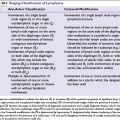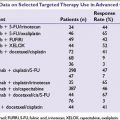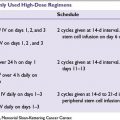Bevacizumab
■A monoclonal antibody against VEGF-A, approved by the FDA in 2009 for the treatment of advanced RCC in combination with IFN-α.
■A randomized, three-arm phase 2 study comparing two different doses of bevacizumab (10 mg/kg and 3 mg/kg IV every 2 weeks) and placebo in cytokine-refractory patients showed a PFS advantage favoring the 10 mg/kg arm (4.8 vs. 2.5 months).
■Two multicenter randomized phase 3 studies with similar trial designs comparing IFN-α alone (9 million international units SC 3 times per week) versus the same dose of IFN-α plus bevacizumab (10 mg/kg IV every 2 weeks) showed superior PFS in the combination arm (5.4 vs. 10.2 months). These improvements in PFS did not appear to translate into significant OS benefits in either of these trials.
■Side effects include hypertension, headache, nosebleeds, headaches, and proteinuria and in some cases gastrointestinal perforation and difficulty with wound healing.
Sorafenib
■An oral tyrosine kinase inhibitor with activity against c-Raf, VEGFR-2, and PDGFR.
■A randomized phase 2 study showed significant improvement in PFS versus placebo (median 24 vs. 6 weeks) in patients with cytokine-refractory metastatic RCC. This finding was confirmed in a randomized phase 3 trial of sorafenib versus placebo (median PFS 5.5 vs. 2.8 months). OS was similar in the two groups (17.8 vs. 15.2 months) and may have been influenced by the trial’s crossover design (patients progressing on placebo could cross over to the sorafenib arm).
■A randomized phase 2 study in metastatic, untreated clear cell RCC failed to demonstrate the drug’s superiority over IFN-α.
■Typically administered at a dose of 400 mg twice a day. Adverse events are similar to those of sunitinib.
■Provides a reasonable option for patients who have failed sunitinib and/or other first-line agents.
mTOR Pathway Inhibitors
The mTOR inhibitors temsirolimus and everolimus are rapamycin analogs believed to act at least in part by downregulating mTOR-dependent translation of HIF.
Temsirolimus
■A prodrug of rapamycin-administered IV.
■The most convincing evidence for the activity of this drug in RCC comes from a randomized phase 3 trial of 626 patients with previously untreated high-risk metastatic RCC (defined as the presence of three or more poor prognostic criteria). All histologic subtypes of RCC were included in this trial. Patients were randomized to receive temsirolimus 25 mg IV per week or temsirolimus 15 mg IV per week plus IFN-α (6 million international units 3 times per week) or IFN-α alone (18 million international units three times per week as tolerated). Single-agent temsirolimus was associated with significantly prolonged disease-free survival and OS compared to IFN-α alone (median OS 10.9 vs. 7.3 months). An exploratory subgroup analysis suggested that both patients with clear cell and those with non–clear cell RCC benefited from temsirolimus. The combined temsirolimus/IFN-α arm had superior disease-free survival compared to IFN-α alone, but there was no difference in OS between the two groups.
■Common adverse events include rash, fatigue, mucositis, hyperglycemia, hypercholesterolemia, and interstitial pneumonitis. Rapamycin analogs are also associated with a risk of immunosuppression.
■Single-agent temsirolimus is a reasonable first-line option for patients with poor-prognosis RCC.
Everolimus
■An oral rapamycin analog.
■In a randomized phase 3 trial of metastatic RCC patients who had progressed on front-line VEGF-targeted therapy, everolimus improved disease-free survival compared to placebo (4 vs. 1.9 months).
■Side effects are similar to those of temsirolimus.
■Both temsirolimus and everolimus are reasonable treatment options for patients who have progressed on sunitinib or other VEGF antagonists.
Cytokines
Until the advent of VEGF-targeted therapy, cytokines were the mainstay of treatment for metastatic clear cell RCC. High-dose IL-2 and IFN-α are the most studied agents in this class.
IL-2
Since the early 1980s, numerous studies have demonstrated the efficacy of IL-2 in patients with metastatic RCC.
■High-dose IL-2 (600,000 to 720,000 international units/kg every 8 hours as tolerated up to a maximum 15 doses) has shown an overall response rate of 15% to 20%, with complete responses in 7% to 9% of patients. Since only a small subset of patients appears to benefit from this agent, no survival advantage has been demonstrated in randomized trials. However, most complete responses were durable, with very few recurrences noted during long-term follow-up. IL-2 is FDA approved for treatment of RCC.
■Responses to IL-2 are best characterized in patients with clear cell histology; its role in other subtypes of RCC is unclear.
■The major limitation of IL-2 is toxicity associated with the high-dose regimen. A high incidence of serious and life-threatening but often reversible complications (notably vascular-leak syndrome, hypotension, multiorgan failure, etc.) occurred in early trials, with resultant mortality rates of 1% to 5%. However, further experience with IL-2 has led to better management of side effects. A report of over 800 patients treated at the National Cancer Institute reported no treatment-related mortality.
■IL-2 has been evaluated in combination with a variety of other modalities, including cellular therapy with lymphokine-activated killer cells and tumor-infiltrating lymphocytes, chemotherapy, interferon, etc. However, combining any of these therapies with high-dose IL-2 appears to provide no additional benefit.
■Lower doses of either IV or SC IL-2 have been evaluated to determine if toxicity could be reduced without compromising efficacy. At least two randomized trials have demonstrated that lower-dose IL-2 leads to fewer responses and, more importantly, a decline in durable complete responses.
■Despite the availability of newer, better tolerated, VEGF-targeted agents, high-dose IL-2 remains a reasonable first-line option for selected patients with metastatic clear cell RCC.
IFN-α
■The overall response rate in treatment-naïve RCC patients treated with recombinant IFN-α is approximately 15%.
■Administered SC in a variety of dosages (5 to 18 million international units) and regimens (three to five times per week).
■Limited long-term follow-up data; durable complete responses relatively rare.
■
Stay updated, free articles. Join our Telegram channel

Full access? Get Clinical Tree






